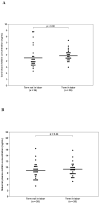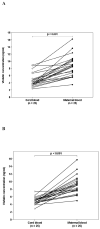Evidence for differential regulation of the adipokine visfatin in the maternal and fetal compartments in normal spontaneous labor at term
- PMID: 20146661
- PMCID: PMC3424273
- DOI: 10.1515/jpm.2010.045
Evidence for differential regulation of the adipokine visfatin in the maternal and fetal compartments in normal spontaneous labor at term
Abstract
Objective: Visfatin, a novel adipokine with metabolic and immunoregulatory properties, has been implicated in the regulation of fetal growth, as well as in preterm labor. A gap in knowledge is whether spontaneous labor at term is associated with changes in the maternal and fetal concentrations of visfatin. The aim of this study was to determine if the presence of labor at term is associated with alterations in maternal and neonatal plasma visfatin concentrations.
Study design: This cross-sectional study included 50 normal pregnant women at term and their appropriate-for-gestational age (AGA) neonates in the following groups: 1) 25 mother-neonate pairs delivered by elective cesarean section without spontaneous labor, and 2) 25 mother-neonate pairs who delivered vaginally following spontaneous labor. Maternal plasma and cord blood visfatin concentrations were determined by ELISA. Non-parametric statistics were used for analyses.
Results: 1) The median visfatin concentration was higher in umbilical cord plasma of neonates born following a spontaneous labor at term than that of those who were born by an elective cesarean section (P=0.02); 2) in contrast, the median maternal plasma visfatin concentration did not differ significantly between patients with and without labor (P=0.44); and 3) there was a significant correlation between umbilical cord plasma concentration of visfatin and both maternal visfatin concentration (r=0.54, P=0.005) and gestational age (GA) at delivery (r=0.58; P=0.002) only in the absence of labor.
Conclusion: Term labor is associated with increased fetal, but not maternal, circulating visfatin concentrations. Previous reports indicate that preterm labor leading to preterm delivery is characterized by an increase in maternal plasma concentrations of visfatin. The observations reported herein support the view that there are fundamental differences in the endocrine and metabolic adaptations in normal labor at term and preterm labor.
Figures


Similar articles
-
Maternal and neonatal circulating visfatin concentrations in patients with pre-eclampsia and a small-for-gestational age neonate.J Matern Fetal Neonatal Med. 2010 Oct;23(10):1119-28. doi: 10.3109/14767050903572190. J Matern Fetal Neonatal Med. 2010. PMID: 20121389 Free PMC article.
-
Maternal plasma visfatin in preterm labor.J Matern Fetal Neonatal Med. 2009 Aug;22(8):693-704. doi: 10.1080/14767050902994788. J Matern Fetal Neonatal Med. 2009. PMID: 19572235 Free PMC article.
-
Visfatin in human pregnancy: maternal gestational diabetes vis-à-vis neonatal birthweight.J Perinat Med. 2009;37(3):218-31. doi: 10.1515/JPM.2009.053. J Perinat Med. 2009. PMID: 19099366 Free PMC article.
-
Visfatin/Pre-B cell colony-enhancing factor in amniotic fluid in normal pregnancy, spontaneous labor at term, preterm labor and prelabor rupture of membranes: an association with subclinical intrauterine infection in preterm parturition.J Perinat Med. 2008;36(6):485-96. doi: 10.1515/JPM.2008.084. J Perinat Med. 2008. PMID: 18598235 Free PMC article.
-
The role of visfatin (PBEF/Nampt) in pregnancy complications.J Reprod Immunol. 2015 Nov;112:102-10. doi: 10.1016/j.jri.2015.09.004. Epub 2015 Sep 21. J Reprod Immunol. 2015. PMID: 26451650 Review.
Cited by
-
Characterization of Visceral and Subcutaneous Adipose Tissue Transcriptome and Biological Pathways in Pregnant and Non-Pregnant Women: Evidence for Pregnancy-Related Regional-Specific Differences in Adipose Tissue.PLoS One. 2015 Dec 4;10(12):e0143779. doi: 10.1371/journal.pone.0143779. eCollection 2015. PLoS One. 2015. PMID: 26636677 Free PMC article. Clinical Trial.
-
Plasma level and expression of visfatin in the porcine hypothalamus during the estrous cycle and early pregnancy.Sci Rep. 2021 Apr 22;11(1):8698. doi: 10.1038/s41598-021-88103-z. Sci Rep. 2021. PMID: 33888798 Free PMC article.
-
Characterization of visceral and subcutaneous adipose tissue transcriptome in pregnant women with and without spontaneous labor at term: implication of alternative splicing in the metabolic adaptations of adipose tissue to parturition.J Perinat Med. 2016 Oct 1;44(7):813-835. doi: 10.1515/jpm-2015-0259. J Perinat Med. 2016. PMID: 26994472 Free PMC article.
-
Visfatin in the porcine pituitary gland: expression and regulation of secretion during the oestrous cycle and early pregnancy.Sci Rep. 2023 Oct 25;13(1):18253. doi: 10.1038/s41598-023-45255-4. Sci Rep. 2023. PMID: 37880346 Free PMC article.
-
Adipokines as Potential Biomarkers in Pregnancy: A Naturalistic Study of Adipokines in Pregnant Women and Newborns.Biomolecules. 2025 Apr 22;15(5):607. doi: 10.3390/biom15050607. Biomolecules. 2025. PMID: 40427500 Free PMC article.
References
-
- World Health Organ Tech Rep Ser. Vol. 916. backcover; 2003. Diet, nutrition and the prevention of chronic diseases; pp. i–149. - PubMed
-
- Prevention of diabetes mellitus. Report of a WHO Study Group. World Health Organ Tech Rep Ser. 1994;844:1–100. - PubMed
-
- Acromite M, Ziotopoulou M, Orlova C, Mantzoros C. Increased leptin levels in preeclampsia: associations with BMI, estrogen and SHBG levels. Hormones (Athens) 2004;3:46–52. - PubMed
-
- Adali E, Yildizhan R, Kolusari A, Kurdoglu M, Bugdayci G, Sahin HG, et al. Increased visfatin and leptin in pregnancies complicated by pre-eclampsia. J Matern Fetal Neonatal Med. 2009:1–7. - PubMed
-
- Akturk M, Altinova AE, Mert I, Buyukkagnici U, Sargin A, Arslan M, et al. Visfatin concentration is decreased in women with gestational diabetes mellitus in the third trimester. J Endocrinol Invest. 2008;31:610–613. - PubMed
Publication types
MeSH terms
Substances
Grants and funding
LinkOut - more resources
Full Text Sources
Medical
Miscellaneous
